Exam Experts
Here to provide you with the best verified exam material for you revision in your studies. Email at
for any kind of assistance.
- 1151
- 0
- 3
Community
- Followers
- Following
423 Reviews received
1154 items
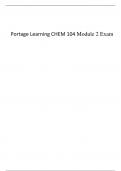
Portage Learning CHEM 104 Module 2 Exam
Portage Learning CHEM 104 Module 2 Exam.Question 1 Identify each of the compounds below as ACID, BASE or SALT on the basis of their formula and explain your answer. (1) Cr(OH)3 (2) HAsO4 (3) CoCO3 Your Answer: 1. base - contains Cr metal + OH polyatomic group 2. acid - contains H + polyatomic group (AsO4) 3. salt - contains Co metal + polyatomic group (CO3) Question 2 For the Brønsted-Lowry acid base reactions shown below, list the stronger acid, stronger base, weaker acid and weake...
- Exam (elaborations)
- • 10 pages •
Portage Learning CHEM 104 Module 2 Exam.Question 1 Identify each of the compounds below as ACID, BASE or SALT on the basis of their formula and explain your answer. (1) Cr(OH)3 (2) HAsO4 (3) CoCO3 Your Answer: 1. base - contains Cr metal + OH polyatomic group 2. acid - contains H + polyatomic group (AsO4) 3. salt - contains Co metal + polyatomic group (CO3) Question 2 For the Brønsted-Lowry acid base reactions shown below, list the stronger acid, stronger base, weaker acid and weake...
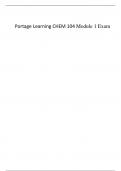
Portage Learning CHEM 104 Module 1 Exam
Portage Learning CHEM 104 Module 1 ExamQuestion 1 In the reaction of gaseous N2O5 to yield NO2 gas and O2 gas as shown below, the following data table is obtained: → 4 NO2 (g) + O2 (g) 1. Using the [O2] data from the table, show the calculation of the instantaneous rate early in the reaction (0 secs to 300 sec). 2. Using the [O2] data from the table, show the calculation of the instantaneous rate late in the reaction (2400 secs to 3000 secs). 3. Explain the relative values of the early...
- Exam (elaborations)
- • 10 pages •
Portage Learning CHEM 104 Module 1 ExamQuestion 1 In the reaction of gaseous N2O5 to yield NO2 gas and O2 gas as shown below, the following data table is obtained: → 4 NO2 (g) + O2 (g) 1. Using the [O2] data from the table, show the calculation of the instantaneous rate early in the reaction (0 secs to 300 sec). 2. Using the [O2] data from the table, show the calculation of the instantaneous rate late in the reaction (2400 secs to 3000 secs). 3. Explain the relative values of the early...

Portage Learning CHEM 103 Final Exam
Portage Learning CHEM 103 Final ExamQuestion 1 Complete the two problems below: 1. Convert 0.0000726 to exponential form and explain your answer. 2. Convert 5.82 x 103 to ordinary form and explain your answer. Answer: 1. Convert 0.0000726 = smaller than 1 = negative exponent, move decimal 5 places = 7.26 x 10-5 2. Convert 5.82 x 103 = positive exponent = larger than 1, move decimal 3 places = 5820 Question 2 Do the conversions shown below, showing all work: 1. 358oK = ? oC 2. 53oC = ...
- Exam (elaborations)
- • 7 pages •
Portage Learning CHEM 103 Final ExamQuestion 1 Complete the two problems below: 1. Convert 0.0000726 to exponential form and explain your answer. 2. Convert 5.82 x 103 to ordinary form and explain your answer. Answer: 1. Convert 0.0000726 = smaller than 1 = negative exponent, move decimal 5 places = 7.26 x 10-5 2. Convert 5.82 x 103 = positive exponent = larger than 1, move decimal 3 places = 5820 Question 2 Do the conversions shown below, showing all work: 1. 358oK = ? oC 2. 53oC = ...

Portage Learning BIOD 171 Final Exam
Portage Learning BIOD 171 Final ExamTrue or False: A virus is considered a microorganism. False. Viruses are not living and as such are not considered microorganisms. Viruses can, however, be classified as microbes, a more general term that includes microorganisms and viruses. 1. What is the smallest biological unit of life? A cell. 2. At a generalized level, all cells are comprised of what? Macromolecules* *A student may also answer: Proteins, Lipids, Nucleic acids and Polysaccharides ...
- Exam (elaborations)
- • 50 pages •
Portage Learning BIOD 171 Final ExamTrue or False: A virus is considered a microorganism. False. Viruses are not living and as such are not considered microorganisms. Viruses can, however, be classified as microbes, a more general term that includes microorganisms and viruses. 1. What is the smallest biological unit of life? A cell. 2. At a generalized level, all cells are comprised of what? Macromolecules* *A student may also answer: Proteins, Lipids, Nucleic acids and Polysaccharides ...
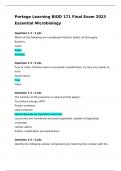
Portage Learning BIOD 171 Final Exam 2023 Essential Microbiology
Portage Learning BIOD 171 Final Exam 2023 Essential MicrobiologyQuestion 1 2 / 2 pts Which of the following are considered Protista? Select all that apply. Bacteria Yeast Algae Amoeba Question 2 2 / 2 pts True or False: Protista retain a unicellular classification, as they are unable to form tissue layers. True False Question 3 2 / 2 pts The function of the lysosome is (select all that apply): To produce energy (ATP) Protein synthesis Lipid synthesis Waste disposal via hydrol...
- Exam (elaborations)
- • 14 pages •
Portage Learning BIOD 171 Final Exam 2023 Essential MicrobiologyQuestion 1 2 / 2 pts Which of the following are considered Protista? Select all that apply. Bacteria Yeast Algae Amoeba Question 2 2 / 2 pts True or False: Protista retain a unicellular classification, as they are unable to form tissue layers. True False Question 3 2 / 2 pts The function of the lysosome is (select all that apply): To produce energy (ATP) Protein synthesis Lipid synthesis Waste disposal via hydrol...

Portage Learning BIOD 171 Essential Microbiology Final Exam
Portage Learning BIOD 171 Essential Microbiology Final Exam 1. A virus is classified as a microbe. True. Although viruses are not living and as such are not considered microorganisms, they can, however, be classified as microbes, a more general term that includes microorganisms and viruses. 2. True or False: The smallest biological unit of life is the molecule. False. The smallest biological unit of life is the cell. 3. What are the 4 main types of macromolecules found in cel...
- Exam (elaborations)
- • 11 pages •
Portage Learning BIOD 171 Essential Microbiology Final Exam 1. A virus is classified as a microbe. True. Although viruses are not living and as such are not considered microorganisms, they can, however, be classified as microbes, a more general term that includes microorganisms and viruses. 2. True or False: The smallest biological unit of life is the molecule. False. The smallest biological unit of life is the cell. 3. What are the 4 main types of macromolecules found in cel...
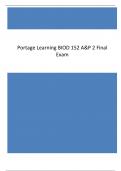
Portage Learning BIOD 152 A&P 2 Final Exam
Portage Learning BIOD 152 A&P 2 Final ExamTrue or False; If false, explain why the statement is false: Bipolar neurons have a central cell body with two extensions. Your Answer: True
- Exam (elaborations)
- • 19 pages •
Portage Learning BIOD 152 A&P 2 Final ExamTrue or False; If false, explain why the statement is false: Bipolar neurons have a central cell body with two extensions. Your Answer: True

Portage Learning BIOD 151 Final Exam
Portage Learning BIOD 151 Final Exam. Define the body movement involved in retraction and protraction. retraction is the movement towards the back of the body (ex: moving your shoulders backwards) protraction is the movement towards the front of the body Answer: Retraction - movement of a structure to be drawn in the posterior direction (drawn backward) Protraction - movement of a structure to be drawn in the anterior direction (drawn forward) Question 2 Not yet graded / 4 pt...
- Exam (elaborations)
- • 16 pages •
Portage Learning BIOD 151 Final Exam. Define the body movement involved in retraction and protraction. retraction is the movement towards the back of the body (ex: moving your shoulders backwards) protraction is the movement towards the front of the body Answer: Retraction - movement of a structure to be drawn in the posterior direction (drawn backward) Protraction - movement of a structure to be drawn in the anterior direction (drawn forward) Question 2 Not yet graded / 4 pt...
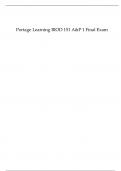
Portage Learning BIOD 151 A&P 1 Final Exam
Portage Learning BIOD 151 A&P 1 Final ExamPortage Learning BIOD 151 A&P 1 Final Exam 1. Define the body movement involved in abduction and adduction. Abduction - movement away from midline Adduction - movement towards midline 2. Name the anatomical pair of terms that best describe the directions of the red arrows in the figure below. (Note that two responses are needed for full credit): Anterior-Posterior or Ventral-Dorsal 3. Determine whether each of the following statements is true o...
- Exam (elaborations)
- • 9 pages •
Portage Learning BIOD 151 A&P 1 Final ExamPortage Learning BIOD 151 A&P 1 Final Exam 1. Define the body movement involved in abduction and adduction. Abduction - movement away from midline Adduction - movement towards midline 2. Name the anatomical pair of terms that best describe the directions of the red arrows in the figure below. (Note that two responses are needed for full credit): Anterior-Posterior or Ventral-Dorsal 3. Determine whether each of the following statements is true o...
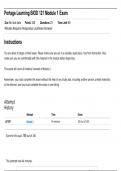
Portage Learning BIOD 121 Module 1 Exam
Portage Learning BIOD 121 Module 1 Exam Explain the internal and external drives that influence our desire to eat. List the positive and/or negative sensations associated with them.
- Exam (elaborations)
- • 22 pages •
Portage Learning BIOD 121 Module 1 Exam Explain the internal and external drives that influence our desire to eat. List the positive and/or negative sensations associated with them.

PORTAGE LEARNING BIOD 151 MODULE 1 – 7 EXAMS A&P 1.
ATI Renal / Urinary Exam 2023.
PORTAGE LEARNING CHEM 210 TEST 8.
HESI EXIT EXAM 1(Questions And Answers)
PORTAGE LEARNING BIOD 151 MODULE 1 – 7 EXAMS A&P 1.